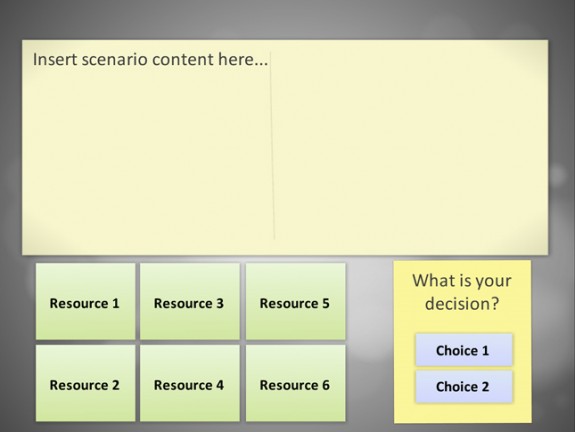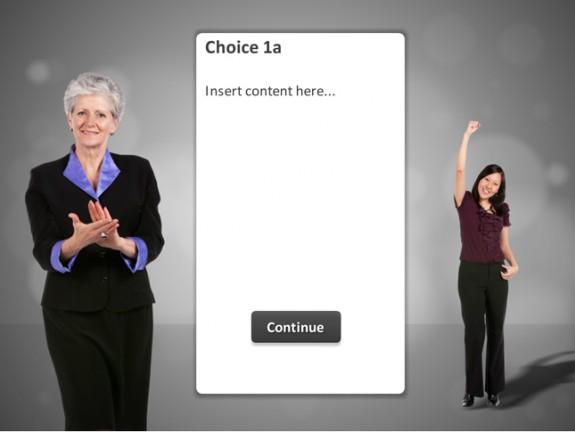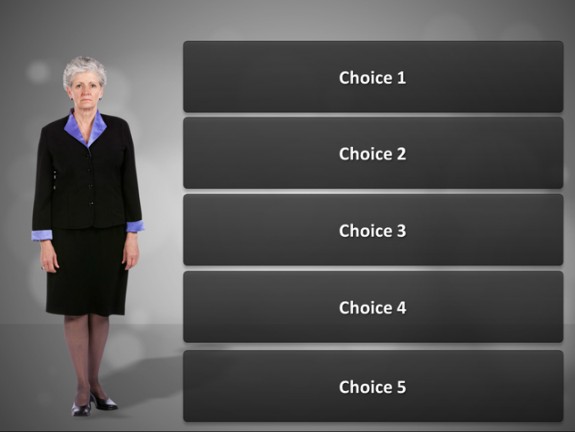
Scenarios are a great way to make online training more engaging. They help participants learn at a deeper level. Instead of just reading, learners must read with the intent to understand and at times place themselves into the particular situation, giving participants information to make decisions. Basically, scenarios turn information into practical application.
Why Use Scenarios?
Scenarios provide learners the opportunity to:
- apply knowledge and practice skills relevant to the situation they face
- analyze, identify issues, solve problems and formulate strategies
- learn by completing structured learning activities which resemble the challenges they are likely to face in the real world
Elements of Effective Scenarios
Here are some elements that designers should consider when creating effective scenarios:
- involves mentally processing and connecting the content presented to the question/task
- models “real-life” thinking processes that the learner has to be able to perform
- presents issue(s) related to the learning outcomes
- is sufficiently complete, complex and focused
- presents a situation, problem, or issue
- appears to be realistic
- events are in a logical order
- content is accurate, relevant, and appropriate
(Here is more research done about the effectiveness of scenarios.)
Scenario Ideas for Instructional Designers
Here are some types of scenarios that you could build upon. Make them your own. Feel free change them to fit your eLearning needs.
1. Let Me Dig Around

This could also be structured like a scavenger hunt. Allow the user to explore lots of different information. Give them a bunch of possible options and let them “dig around” to find the answer.
Example in Action: Show a customer that wants to do a bank transaction at the teller window. Below you have a driver’s license, bank system screenshot with account information, deposit tickets, and an image of the check. Ask the user to review the customer deposit and determine if the transaction should be processed or not.
2. Who Dun It?

Present the setup information and then show a list of characters. Let the user click on characters to learn about them. The user then selects their answer.
Example in Action: This could work great for a policy/regulatory type course. You could present an example of someone applying for a loan. Then click on each person to see how they would present the loan information and quote the rate. The user would choose the option that followed all of the regulations and policies.
3. Can’t We Just Talk About This?

Show two people talking back and forth. Although this might be very simple, it’s a nice way to break up a page. Instead of having a bunch of text from a conversation on the screen at the same time, go ahead and turn it into a progression. Just show one part of the conversation as a time and let it build.
Example in Action: Use this to show how a conversation might play out. You could present a situation such as an angry customer. Let’s say that a customer is calling about a billing error. Let the user choose option A, B, and C to identify different ways to handle this conversation.
4. Will I save the world?

Have a series of questions that take the user down various paths to different endings. Just think about the old choose your own adventure books.
Example in Action: This could work great for sales teams. Present a customer bio with their needs. Bob is 35, married, works in a warehouse, and rents a house. How could you start a conversation to help him see the benefits of life insurance? List a series of conversation starters and let the sales rep choose one. Then put him/her down different paths to a final outcome.
5. Line Em’ Up!
The user must go through the scenario in a certain order. If they get things out of order they fail the task.
Example in Action: Changing a tire isn’t too hard if you following a certain task order. Have a picture with various items that are used to change a tire. Make the user click the items in order that they are used. If the user clicks on the new tire before clicking on the jack then the images reset and they start over.
6. Ain't Nobody Got Time for Dat!
Add a bit of stress to the scenario by adding a timer to the situation. The user must learn to make informed decisions within the allotted time.
Example in Action: It’s time to make some burgers. Have customer orders appear on top and make the user assemble the hamburgers correctly within a defined time limit. If they make too many mistakes and/or don’t do it in the allotted time then the customers get angry and leave. If the user looses too many customers then they need to find a new job.
7. Resistance is Futile
At some point the Borg will assimilate us all. (If you’re not a Treky then you can learn more about the Borg.) This type of scenario will force the user to get the correct answer as some point. They can’t continue until that happens.
Example in Action: Use this scenario type when teach concepts that are high risk and must be done correctly. Training CPR would fall into this category. Present an emergency situation and have the user click on the steps to do CPR. If they get a step incorrect then they must correct it before moving on. It is vital that this skill is learned properly.
8. Don’t Hide Behind Momma’s Skirt!
So, I’ll show you how to do it but after that you’re on your own. The user can see examples but then must go into the “real world” and prove themselves.
Example in Action: This could be good for system training. Show the user how to setup new accounts on the software and then let them do it on their own. Another good use would be for math. Let’s say a teacher wants to build a scenario on the Order of Operations. Show an example equation and describe what parts of the equation get calculated first. Then show another equation and let the student do it on their own.
Extra Bonus Scenarios
Thanks for reading this far faithful eLearning reader! Since you've read this far (or scanned this far) I'm going to give you an extra bonus scenario ideas!
Survival - This Survival scenario puts you into the scenario of an airplane crash landing in the mountains. You must make decisions to see if you can survive. See the Smart Builder example.
Quarantine - A branching scenario where you make decisions on how to run a military base for aliens. See more of the Quarantine example in the Adobe Blog.
Connect with Haji Kamal – Built for the US Army on how to create rapport across cultures. See Connect with Haji Kamal.
Additional Scenarios Resources
Awesome eLearning Scenario Templates
Cathy Moore’s — Tips on How to Write Good Scenarios
Cathy Moore’s — When you need a branching scenario
SHRM — 10 Scenarios to Address How to Have Difficult conversations with employees (classroom based material that could be built as an online course)
Kineo — 3 Ways to Use Scenarios







